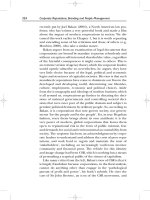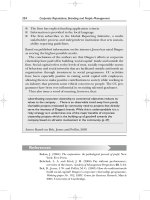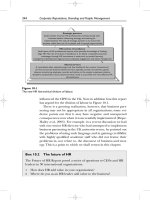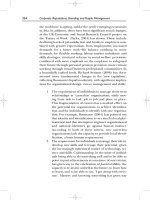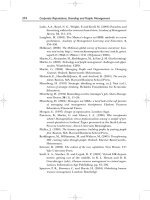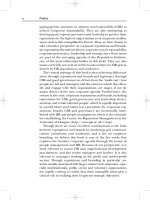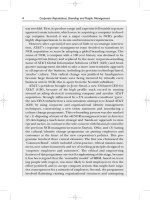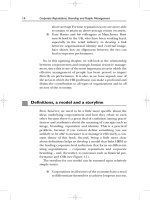Tài liệu Corporate Reputations, Branding and People Management 10 ppt
Bạn đang xem bản rút gọn của tài liệu. Xem và tải ngay bản đầy đủ của tài liệu tại đây (143.24 KB, 10 trang )
We will discuss this link between identification in Chapters 3
and 4, when we look more closely at engagement.
Their cause-and-effect model is set out more formally in
Figure 2.8, which shows how reputation building, personalized
communications, the quality of communications and the
EQ (or emotional appeal) are linked through increased levels
of organizational identification with behaviours that are
supportive of corporate reputation. The model also highlights
the questions used to assess the levels of organizational
identification.
Plural reputations are lead indicators of brands
Though Fombrun and his colleagues have certainly advanced
our understanding of corporate reputation, there are two criti-
cisms we can make. The first is that it is not quite clear enough
in setting out the relationship between reputation and branding,
which are sometimes treated synonymously. Grahame Dowling’s
(2001) work is particularly helpful in this regard by making clear
links between reputations and what he calls ‘super-brands’. In
74 Corporate Reputations, Branding and People Management
The degree of fit or alignment
among the beliefs and feelings held
about an organization by people and
groups and what they personally or
collectively value, e.g. ‘chicness’,
professionalism and
social responsibility are values
which are held to be important by
potential employees, so the
organization maintains a reputation
for these characteristics
Reputation
Brand
The levels of trust and confidence that
an individual or group has in the
organization’s ability to deliver
continuously high levels of what they
value about the organization’s image
and the support they give to its
products and services, e.g. the
organization develops an external
brand as a provider of chic,
professional and socially responsible
products and services and an
employer brand as a chic, professional
and socially responsible, and
customers/employees continue to
buy the products and recommend
them to others
Figure 2.8
The relationship between reputations and brands (based on Dowling,
2001).
line with our earlier discussion on the importance of corporate
brands, he sees the valued outcomes of reputations as follows:
■ building trust among customers, employees and other
stakeholders that the organization will act in their best
interests or that of the community
■ building confidence among customers, employees
and other stakeholder that the organization will con-
tinue to value their contributions and their trust
■ lending support to the organization by continuing to
use its products and services and to recommend others
to use them.
It is from high levels of such confidence, trust and support
for organizational reputations (for valued characteristics such
as superior performance, fairness, honesty, social responsibility
and professionalism) that super-brands result.
The second criticism is of the unitary approach of Fombrun
and his colleagues, which culminates in the global measure of
reputation. Again, Dowling’s work is helpful in this regard in
pointing out the plural nature of reputations. His argument, like
some of the writers on organizational culture and identity, is that
we cannot sensibly talk about a corporate reputation in a unitary
sense because reputations will be judged differently according to
who is doing the judging, when and why they are judging, and
the criteria they use to judge. Reputations, he argues, arise from
the degree of fit or alignment between two key elements:
■ the beliefs and feelings of different groups of stake-
holders about an organization (which he defines as
image but we see as part of reputations)
■ their individual or collective values (personal values)
(see Figure 2.1).
Since, as he contends, brands flow from the levels of trust,
confidence and support that stakeholders have in the ability of
the organization to deliver what they value about the organiza-
tion’s image/reputation, by definition perceptions of brands
will also be different, e.g. among different customer segments,
different groups of employees, potential employees, etc.
Dowling is not alone in emphasizing the plural nature of
reputations. For example, Hatch and Schultz (2001) point to
Chapter 2 Managing corporate brands and reputations 75
the interaction between the objective and subjective evalu-
ations of four distinct groups as the source of reputational
pluralism. These groups are:
■ Functional groups – for example, through informal
interactions at sales meetings, employee storytelling
or accounts from satisfied or dissatisfied service pro-
viders. These incidents strongly influence an organi-
zation’s reputation but are largely uncontrollable.
■ Different customer segments – for example, young,
old, educated, urban, suburban, class, etc.
■ The business press and special interest groups – such
as the rankings of the best places to work and industry
press ratings of organizations, as outlined above.
■ Normative and potential stakeholders – such as pos-
sible recruits, shareholders and other funders, trade
associations, government regulatory agencies, profes-
sional organizations and the community at large.
So it follows that no organization in reality has a single rep-
utation since different stakeholders are likely to value different
images of an organization. Indeed, what you see is likely to
depend on where you stand; if you place high value on profes-
sionalism, you are likely to look for that element in an organi-
zation’s projected image, say from a business school that is
research-led with well-known teachers. On the other hand, if
you place a high value on friendliness or leading-edge enter-
prise, you would probably look for a different kind of school.
As a result, the ‘designers’ of corporate reputations need to
be clear about who they are aiming to influence and the best
methods of influencing different groups of stakeholder.
However, at a practical level, the debate between the singular
and global view of reputations and brands may be a false one,
since Fombrun has always acknowledged the problems of an
aggregated notion of corporate reputation. He points, instead,
to its practical value in helping organizations identify their
relative standing, understand the factors that have contributed
to it and highlight the kinds of actions that might be needed to
improve it. In effect, he has gone for simplicity and practicality
in moving the conversation along on reputations rather than
overcomplicating the story before readers begin to understand
76 Corporate Reputations, Branding and People Management
it. At the time of writing Fombrun and Van Riel are working on
a development of the RQ to address the problems of using
aggregate measures with different stakeholders and to address
one of the key problems of understanding, what they acknow-
ledge to be a key driver of reputations – human resource man-
agement and employee communications (Fombrun, 2005).
Conclusions
In this chapter we have examined, in more depth, the notions of
branding and reputations, showing how these are distinctive but
related ideas. Whilst branding is the better-known concept, espe-
cially among practitioners in the for-profit sector, our argument
is that we have to work with both notions. In our model, we have
described reputations, which are best thought of as plural, as lead
indicators of corporate brands. Brands flow from good or poor
reputations held by different groups of people about the organi-
zation’s image. These evaluations are quite specific to the particu-
lar values of different groups, so are more usually associated with
a wider range of stakeholder and agendas, including good govern-
ance, CSR, diversity and human resource management. Reputa-
tion is also a more intuitive idea, takes longer to build and is a
more acceptable term to organizations in the not-for-profit sec-
tor. Moreover, there is an increasing volume of material on repu-
tation management, which is very well researched and is shown to
have strong links to performance. At the heart of the reputation
management approach is the link between external image and
internal identity, to which we now turn in Chapter 3.
References
Aker, D. A. (2004) Brand portfolio strategy: creating relevance, differenti-
ation, energy, leverage and clarity. New York: Free Press.
Apéria, T., Brønn, P. S. and Schultz, M. (2004) A reputation analysis
of the most visible companies in the Scandinavian countries,
Corporate Reputation Review, 7, 218–230.
Argyres, N. and McGahan, A. M. (2002) An interview with Michael
Porter, Academy of Management Executive, 16 (2), 43–45.
Chapter 2 Managing corporate brands and reputations 77
Arkin, A. (2005) Is it possible for a tobacco company to act respon-
sibly?, People Management, 1 September, pp. 28–31.
Barney, J. (1991) Firm resources and sustained competitive advan-
tage, Journal of Management, 17 (1), 99–120.
Barney, J. (2002) Strategic management: from informed conversa-
tion to academic discipline, Academy of Management Executive, 16
(2), 53–58.
Barrow, S. and Mosley, R. (2005) The Employer Brand
®
: bringing the best
of brand management to people at work. London: Wiley.
Belanger, J., Berggren, C., Bjorkman, T. and Kohler, C. (eds) (1999)
Being local worldwide: ABB and the challenge of global management.
Ithaca, NY: Cornell University Press.
Berthon, P., Hulbert, J. M. and Pitt, L. F. (1999) Brand management
prognostications, Sloan Management Review, 40 (Winter), pp.
53–65.
Boxall, P. and Purcell, J. (2003) Strategy and human resource manage-
ment. Basingstoke: Palgrave Macmillan.
Brymer, C. (2003) What makes brands great?, in R. Clifton and
J. Simmons (eds), Brands and Branding. Princeton, NJ: Bloomberg
Press, pp. 65–76.
Buckley, E. (2005) Internal branding, in A. M. Tybout and T. Calkins
(eds), Kellogg on branding: the marketing faculty of the Kellogg School
of Management. Hoboken, NJ: John Wiley, pp. 320–327.
Davies, G. with Chun, R., Da Silva, R. V. and Roper, S. (2003) Corporate
reputation and competitiveness. London: Routledge.
de Chernatony, L. (2001a) From brand vision to brand evaluation.
Oxford: Butterworth–Heinemann.
de Chernatony, L. (2001b) The diverse interpretations of brands, The
Marketing Review, 1, 283–301.
Dowling, G. R. (2001) Creating corporate reputations: identity, image and
performance. New York: Oxford University Press.
Du Gay, P. (1996) Consumption and identity at work. London: Sage.
Economist (2005a) Moving on: manufacturing is out; knowledge-
based industries are in, Economist, 13 January.
Economist (2005b) Face value: the man with two daggers, Economist, 27
August, p. 60.
Economist (2005c) Fast food’s yummy secrets, Special Report, Yum!
Brands, Economist, 27 August, pp. 61–62.
Ewing, M. T., Pitt, L. F., de Bussy, N. M. and Berthon, P. (2002)
Employment branding in the knowledge economy, Inter-
national Journal of Advertising, 21 (1), 3–23.
Fombrun, C. J. (1996) Corporate reputation: realizing value from the cor-
porate image. Boston, MA: Harvard Business School Press.
78 Corporate Reputations, Branding and People Management
